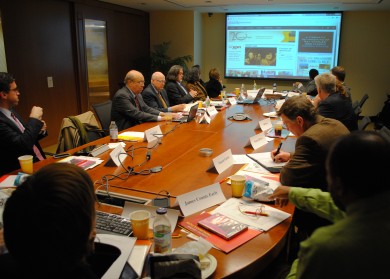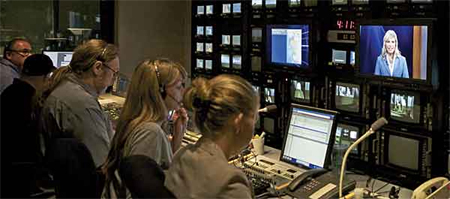Tag: Public Media Futures
Futures Forum to showcase practices for assessing pubmedia impact
The Public Media Futures Forum, in collaboration with the Center for Investigative Reporting, will host “Understanding Impact,” a two-day discussion in Washington, ...Forum will focus on philosophies of public media’s local service
The next Public Media Futures Forum, the latest in an ongoing series of events examining topics of interest to the field, will ...Public media leaders debate value of internships, paid and unpaid
As public and for-profit media companies come under new scrutiny for compensation of interns, public media executives debated how decisions to pay ...The Future of Media Leadership: A Storify
Follow the conversation around the next generation of public media leaders with Current's Storify of the June 14 forum.Futures Forum explores pubmedia’s leadership transition
Upcoming leadership changes in public media will be the focus of Friday’s Public Media Futures Forum in Washington, D.C., the latest in ...Panel discussion focuses on public media’s role in presenting arts to Americans
A Feb. 20 Public Media Futures Forum in Washington, D.C., brought together public media funders, presenters and programmers in a wide-ranging discussion ...Wednesday forum to explore public media arts coverage
The latest in an ongoing series of Public Media Futures forums will spotlight public broadcasting’s work surrounding the arts. The Feb. 20 ...Radio g.m.’s adapt business models for newsgathering
Public radio is adapting too slowly to the competitive challenges it faces from Internet-based media platforms, and the pace of change must ...Pubcasting’s push into online news delivery has built-in limitations
SAN FRANCISCO, Calif. – At a forum of leading public media professionals, participants expressed mixed feelings about whether public media can, or ...Top prospects for expanding pubradio revenues examined at Public Media Futures Forum
SEATTLE — When public media development consultants and station leaders gathered at the University of Washington’s Seattle campus on July 10 to ...Questions to ask before you collaborate
For two decades, Dick McPherson has managed the McPherson Associates’ Public Media Co-op, through which 30-plus stations with more than 25 percent ...Multiplatform: KPBS extends its news expansion to television
With the launch of KPBS-TV's Evening Edition, the pubcasting outlet took another big step towards General Manager Tom Karlo’s ambitious goal to become “the ...Cohesion: It helps when collaborators want the same things
There’s a growing disparity between the haves and have-nots among public stations. Their abilities to expand services and revenues are diverging. And ...Local/national fundraising ‘rules of the road’ needed
While a local public broadcasting station traditionally romances big-donor prospects in its locality, it can occasionally find itself in a jealous spat ...Upsides: Reconceived public stations can ‘be more PBS’ and be more local
The stations are here so they can understand and illuminate a community’s aspirations and concerns, engage people in the life of their ...






